So much about bird photography can be attributed to Timing and Luck, and much of the aspect of timing is about when sunlight is available and at its best for photographing. As you may recall, I have been planning to check back on the progress of the 2 families of Common Loons photographed in July to photograph the young loons’ new look after they molt from their second down plumage into their first feathered plumage. Although I was anxious to get back to that beautiful Minnesota lake to check back on the loons and reconnect with my great friends Dave and Linda, I might have waited another week or 2, except that a surprise visit by Dwight, who was on last year’s initial loon voyage sparked a second thought.
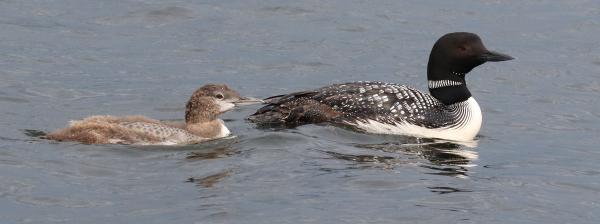
After visiting me and other friends and family in his hometown, Dwight planned to spend a couple days with Dave at Little Pelican Lake again. That got me thinkin’, and as I watched the weather predictions with my mid-week days off in mind, it looked like the stars might align so we could reconvene our loon photo group, including Linda, who joined Dave (Andy) and I during the July pontoon voyage when we found and photographed 2 pairs of Common Loons, each with a downy hatchling between 2 and 3 weeks old. Fast forward to last week, it looked like there was a window of time during late afternoon Wednesday when sunlight would provide a photo opportunity – if we could re-find the loons.
While driving 3 hours to Little Pelican Lake I was counting on a window of time between 3pm and 5pm to be on the water, photographing, before a low front would bring rain to the lake region by the 6 o’clock hour. Committed, hoping for the best – for a chance – and looking forward to getting the gang back together, everything looked like we should have that sunlight period with scattered clouds after 3. I arrived to meet Andy and Dwight almost to the minute at 3pm – just as a rogue cloud dropped a sprinkling rain. Linda arrived just as the sprinkles ended and took credit for the sun re-emerging. We boys agreed it must be so, and we boarded Andy’s luxury pontoon boat and we were motoring stealthily to the area where we photographed the first loon family with the slightly older loon hatchling.

Blessed with loon eyes, I spotted the first loon and Andy slowly, quietly slipped into position between the loon and where the sun was hidden by a hopefully temporary cloud. Sure enough, a moment later, there came the sun, and I was in business photographing the female of the first pair. A few moments later I took a second look around and there was the male, about 50 feet behind us; and the young loon?
As we observed and I photographed, the female loon began preening, and in moments provided an interesting photo op as it repeatedly opened its beak, perhaps stretching its mouth a bit. The only problem was that a cloud shaded the sun – but for just a moment. The loon opened its beak wide again, first pointing forward as before; but then, as I took a series of photos, the loon raised its head into an upright position with its mouth still opened wide, which elicited a considerable level excitement from the gang. The resulting still photos are somewhat unique and suggest the loon was calling, but we didn’t hear a note. Was the sound beyond our human hearing range? Most likely no; it wasn’t calling, it was stretching as part of its preening and maintenance episode.
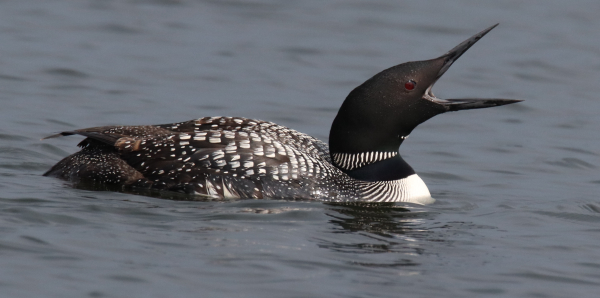
A bit surprised that the male didn’t react to our interest in his mate, and disappointed that the young loon was nowhere to be seen, we repositioned to get closer to the male. Our move seemed to prompt him to join the female, and we opted to look for the other loon family as the expected storm was becoming more ominous and sunlight becoming more precious. As Andy ferried us round a point and into the next bay, my loon eyes focused in on an adult and a young loon near where we left them 3 weeks earlier. From a distance, now the question was: How had the transition from down-covered hatchling progressed toward a fully feathered young loon?
As Andy slowed to a quiet float, I took a couple initial photos of the young loon, but a bank of clouds was withholding sunlight from the tranquil scene. Would the clouds relinquish their hold on the loons? In the meantime, it was possible to get a better look at the young loon and assess the progress of its molt from longish light-brown down to a new cover of tan plumage on its dorsal side and white plumage below. The tan plumage was now covering the back and upper wings, as well as its face, with down still in place along the edges of the back, the rump, and the nape of the young loon. We noted that it had doubled or tripled its size, and was a most attractive young loon. And then it happened – the sunlight returned to enlighten the scene and the loons.
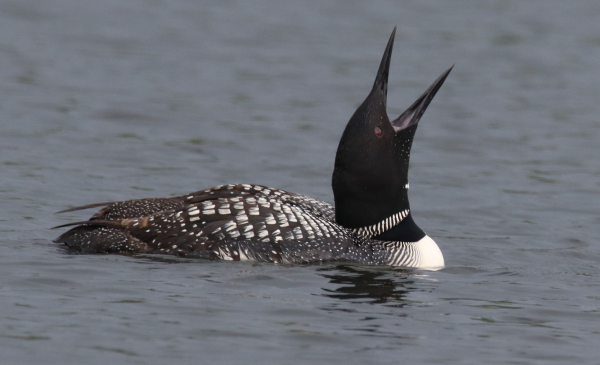
I took a few more photos of the young loon, some with the adult at its side, now highlighted by brighter, crisper colors that made the resulting photographs pop in a beautiful way. Just then my loon eyes noted the appearance of the male, swimming in our direction with a fish in its beak. The male swam directly toward the young loon, but it was interesting to see that the young loon had almost no interest in the fish; probably an indication that it was well-fed, or overfed. But the male was persistent, and it dropped the fish in front of the young one, seeming to be interested in getting the young loon to “re-catch” the fish. It dropped and re-dropped the fish for the young loon, but in the end I think the male ended up eating the fish.
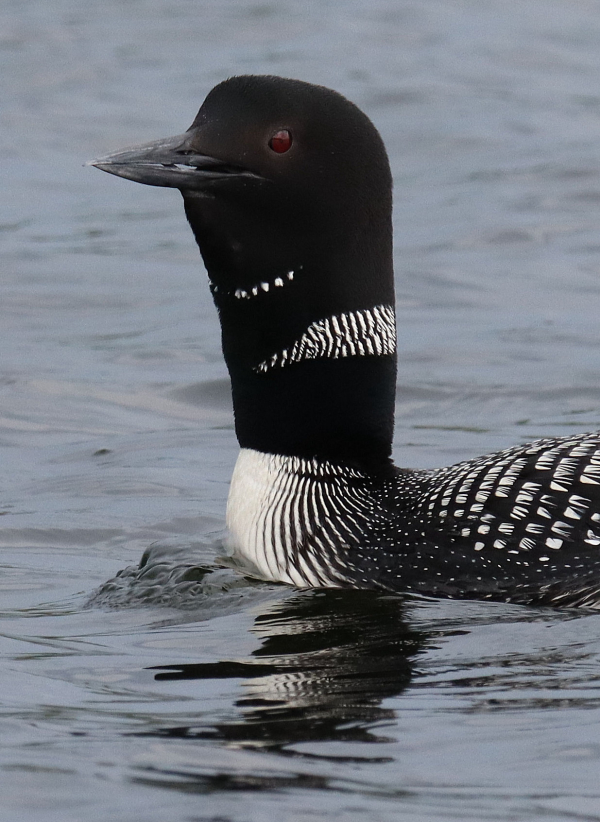
With its throat fully expanded, this photo of a calling male was cropped to show just the front section of the loon, with the hope that you have a closer view of its beak while it emits the classic wild call heard across Minnesota lake country each summer. Note that the beak is closed at the sharp end, but slightly open nearer the base of the beak, where you should be able to see blue water showing from the opposite side. We also hope you can see that the blue line inside the opening between the mandibles is broken by what looks like a black line, which is actually the tongue moving within the beak to facilitate the loon’s vibrant call (330mm zoom, f-8 aperture, 1/800 shutter speed, ISO 800).
|
Moments later, the male began calling; even swimming closer to us and calling again while I took a series of photos. Although Linda, Andy, and I enjoyed the loons calling 3 weeks earlier, the pair from the previous year didn’t call in our presence, so this was a new thrill for Dwight (it was a thrill for all of us). We noted in my previous photos that the loon didn’t actually open its beak when it called; with its throat fully expanded, the beak was closed at the sharp end, but slightly open nearer the base of the beak to allow the forced air to flow outward during the call.
The male swam back the way it came, perhaps to resume fishing, and the female and maturing young loon soon followed in that direction. At that point I knew the light wasn’t going to last forever, and that I had all the photos I needed, so we would break away soon to return the loons to their solitude. Even so, I continued to photograph the advance of the female with the hatchling following close-by as Andy, without pressing the loons in any way, paralleled the 2 loons as they swam for a short distance. Although the rest of us were fixed on the birds, from his position behind the wheel Andy remarked about how fast the loons were swimming, also noting that they were swimming into the increasing wind. It was definitely a memorable part of our loon expedition as the sun provided the best light of the photo session.
What fun it was, and how especially lucky we were to have the periods of sunlight when in the company of the 2 loon families, but we bid the loons so long. Moments later, what would turn out to be the last sunlight of the afternoon was blocked by the ever-more stormy looking low clouds blowing in from the northwest – the low weather front was upon us. After docking, we spent a sweet hour inches above the water on the dock, visiting and watching the storm roll in, hearing the loons calling in the distance occasionally, and appreciating it when an Osprey landed on top of a tree overhanging the lake a few dozen feet away.
Realizing that our next photo update of the young loon would be about 3 weeks away – unfortunately Dwight will have returned to Portland and Linda back to Hollywood. But Andy is planning to check on adjacent Pelican Lake in the meantime, and he may add another twist on our loon photography, while hoping we can also document the young loon we photographed twice now in its full first-year plumage. We will toast Linda and Dwight, and appreciate the fun we’ve had on these loon expeditions shared among great college friends.
Photography Details
Although the photos show the Common Loons highlighted in perfect sunlight, the color of water reflects the storm clouds overhead, adding a dark gray color to the surrounding water, quite different from the usual blue water images I tend to prefer. But the darker water created an emphasis on the birds, and considering the weather conditions, it was especially rewarding just to have sunlight to photograph with when in the presence of the 2 pairs of loons, and especially when photographing the maturing young loon.
With the mostly overcast conditions, I changed the ISO setting on my camera from the usual 400 ISO to 800, and considering how the images turned out, that was an excellent move. It was an improvement that provided increased utilization of the existing light in the midst of dull background waters, while also permitting faster shutter speeds and a bit wider aperture. When photographing a single bird, I used an f-8 aperture to emphasize a faster shutter speed; but I switched to a broader aperture of f-10 when photographing more than 1 loon within a frame.
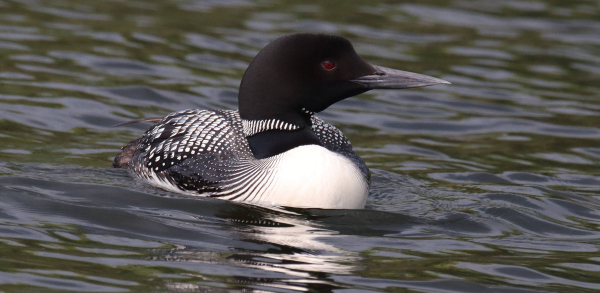
More often than in other photo opportunities, I was able to use less zooming power at times, reducing the magnification when relatively close, while using the full 600mm reach of my Tamron 150-to-600mm zoom lens when needed.
Just as when I use my car or van as a “mobile blind,” Andy would cut the engine when we were in position to photograph. In addition to the obvious photo reason to stop the vibrations caused by the running engine, it was also a big plus to keep the engine off to keep the loons more relaxed, and it also provided the gang with a more relaxed, quiet, still experience on board the luxury pontoon.
The only exception to turning the engine off while photographing in the presence of the loons was at the end of our photo ride when Andy paralleled the female and young loon as they swam into the wind. But the loons didn’t seem concerned, and the camera’s shutter speed was fast enough that the photos I took were sharp images in what would be the last sunlight of the afternoon.
Our success on this loon photo trip absolutely came down to Timing and Luck! There was a perceived window of opportunity when sunlight should be available – Timing. And while the lighting conditions were not as good as hoped for, they were adequate, and more – what Luck!
Article and photographs by Paul Konrad
Share your bird photos and birding experiences at editorstbw2@gmail.com